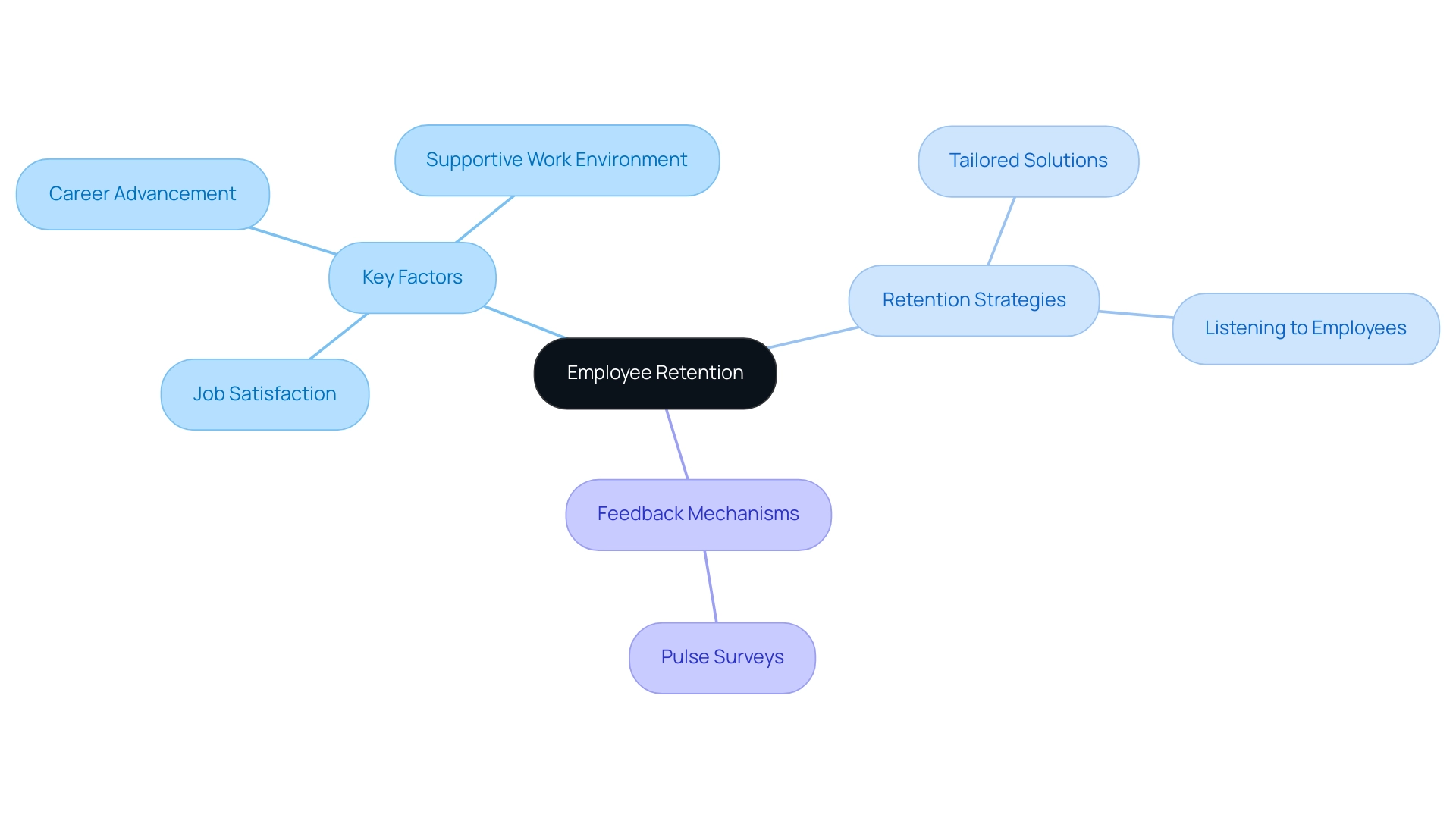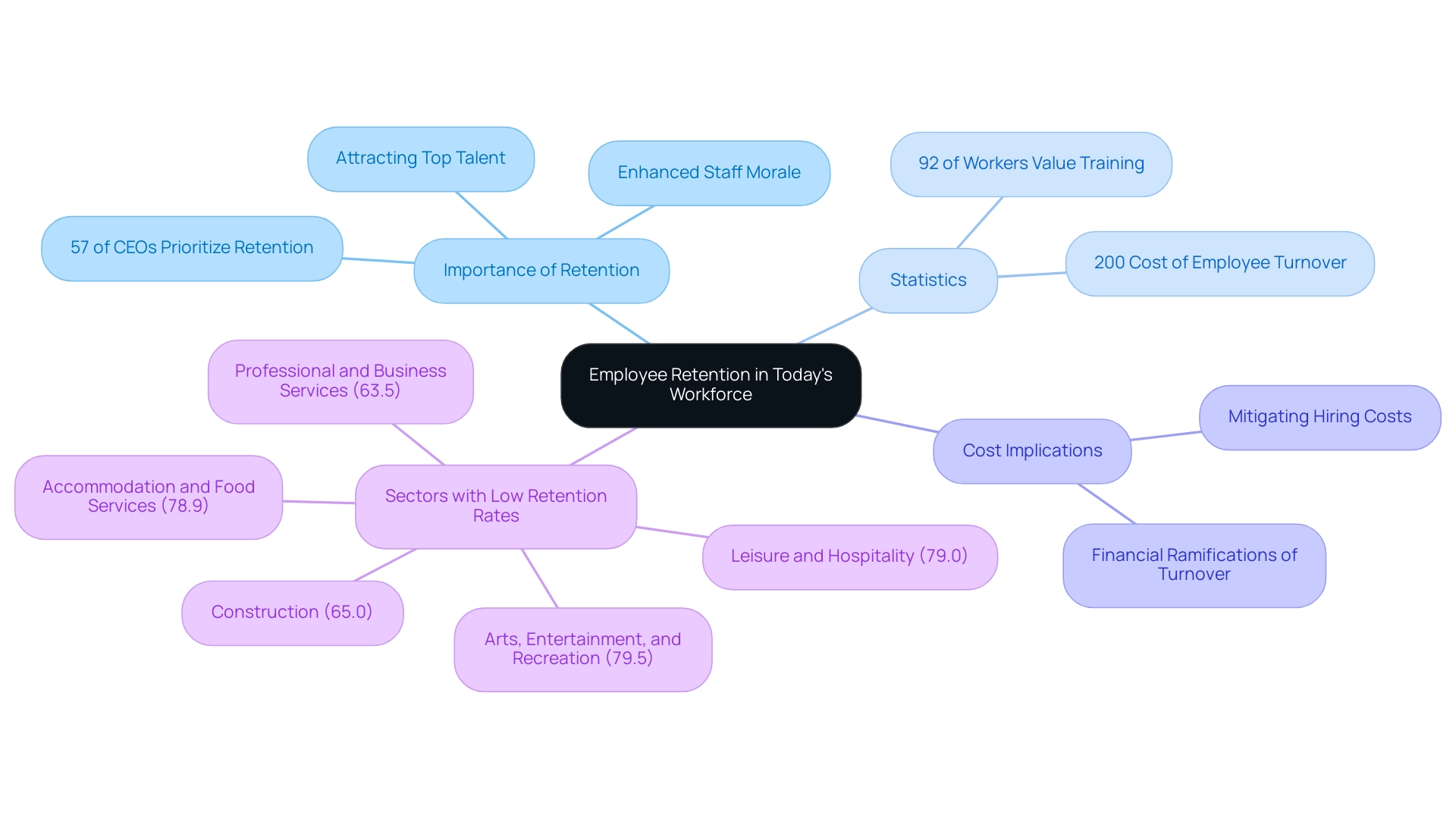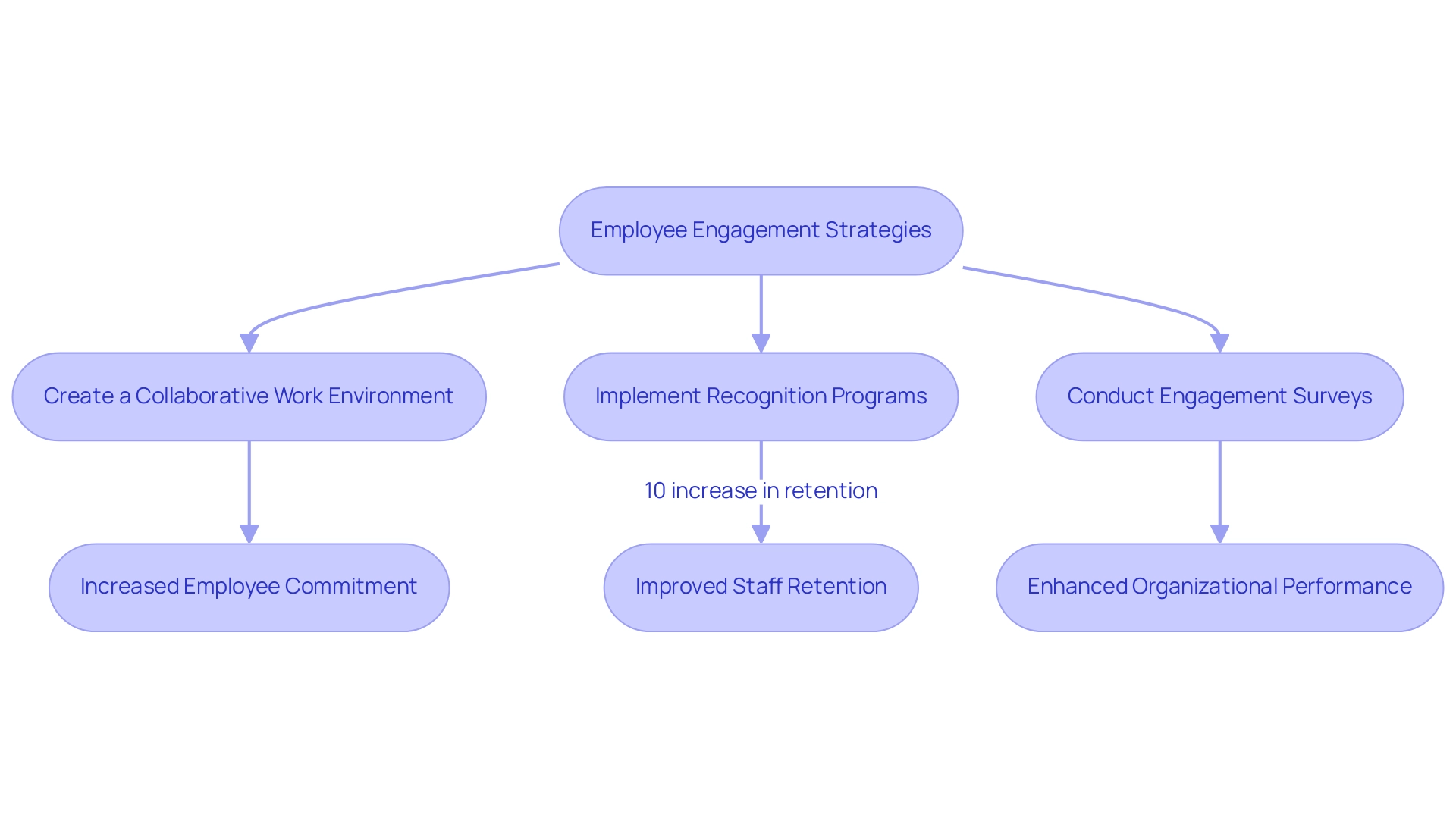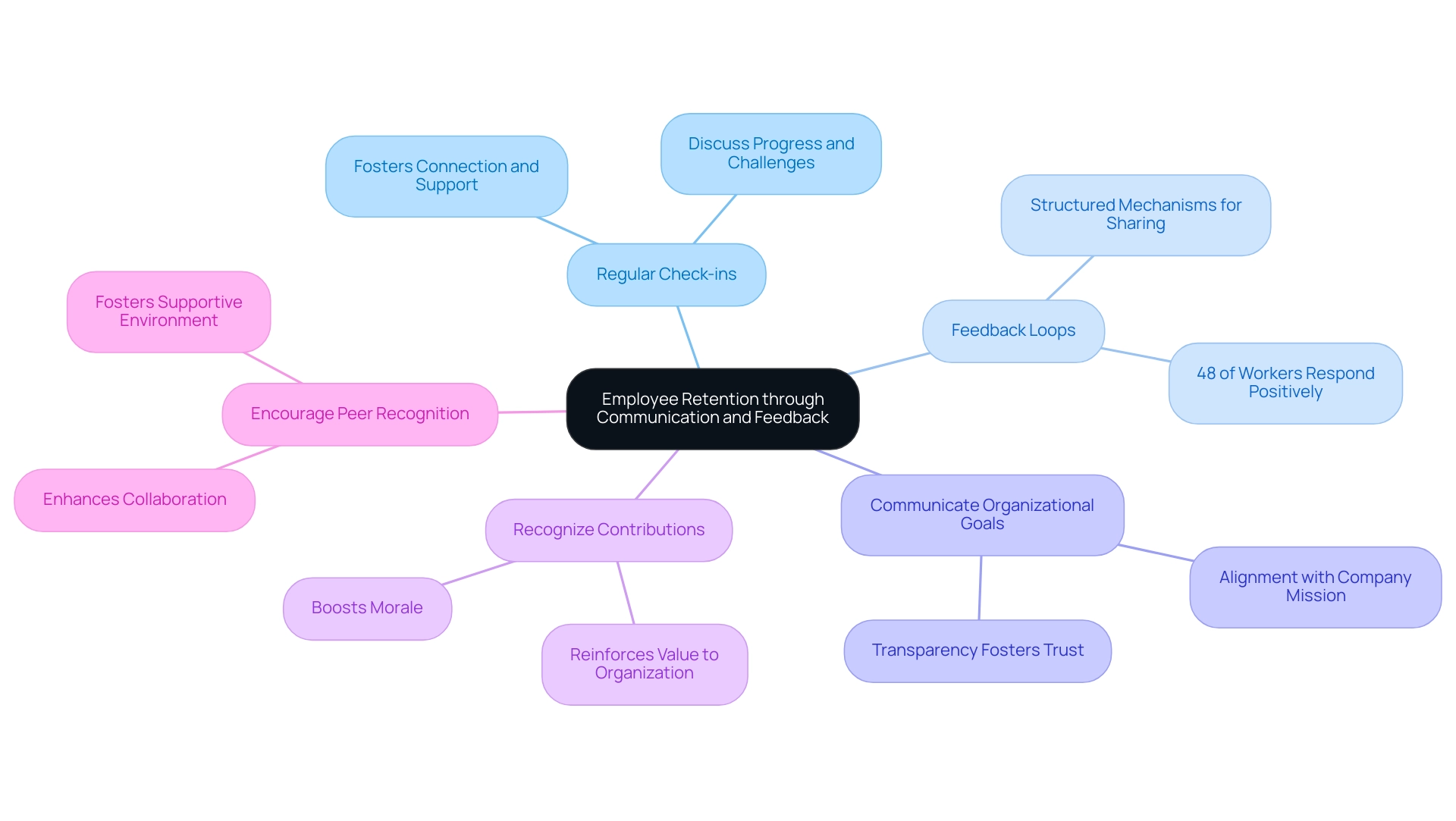Overview
Proven employee retention solutions for HR managers are pivotal in fostering job satisfaction, career advancement opportunities, and a supportive work environment, all of which enhance loyalty and reduce turnover. Notably, effective strategies—such as competitive compensation, responsive feedback mechanisms, and recognition programs—not only elevate employee morale and productivity but also significantly lower recruitment costs. This underscores the critical link between retention practices and organizational success.
Consider the implications of neglecting these strategies: high turnover rates can disrupt team dynamics and inflate hiring expenses. By investing in robust retention solutions, organizations position themselves for sustained success.
In conclusion, the commitment to developing a supportive workplace culture is not merely an HR responsibility; it is a strategic imperative that drives organizational excellence. Embrace these proven solutions to not only retain top talent but also to foster an environment where employees thrive.
Key Highlights:
- Employee loyalty is crucial for maintaining a stable workforce and reflects a positive workplace culture.
- 57% of CEOs prioritize employee retention solutions and engagement as key business strategies for 2025.
- Key factors influencing employee loyalty include job satisfaction, career advancement opportunities, and a supportive work environment.
- Responsive feedback mechanisms, such as pulse surveys, are essential for assessing employee sentiments and improving retention strategies.
- Effective employee retention solutions can reduce recruitment costs and enhance organizational performance.
- High staff loyalty correlates with improved morale, innovation, and customer satisfaction.
- Competitive compensation and benefits are vital for attracting and retaining top talent in high-demand sectors.
- Career development opportunities significantly influence employees’ decisions to stay with their organizations.
- Promoting work-life balance through flexible arrangements can enhance staff loyalty and productivity.
- Recognition and appreciation programs foster a culture of commitment and can increase retention rates.
- A supportive workplace culture that values communication, diversity, and employee well-being is essential for retention.
Introduction
In the contemporary business landscape, employee retention has emerged as a decisive factor in determining organizational success. As companies grapple with the challenges of a competitive job market, understanding the intricacies of retaining talent becomes paramount.
With a staggering 57% of CEOs identifying employee engagement and retention as top priorities, organizations must not only focus on attracting skilled professionals but also on fostering an environment that encourages them to stay.
What are the critical elements influencing employee retention? This article delves into effective strategies for enhancing loyalty and highlights the profound impact of a positive workplace culture on overall performance.
By prioritizing retention, organizations can cultivate a dedicated workforce that drives innovation and sustains long-term success.
Understanding Employee Retention: A Key to Organizational Success
Employee loyalty is a critical measure for companies, reflecting their ability to maintain a stable workforce over time. In 2025, robust loyalty rates are increasingly recognized as indicators of a thriving workplace culture, where employees feel valued, engaged, and motivated to contribute to their organization’s success. Research shows that 57% of CEOs prioritize employee retention solutions and personnel engagement, highlighting the significance of this issue in today’s competitive environment.
Understanding the key factors that influence staff loyalty is essential for HR managers, as these elements directly affect productivity, morale, and overall organizational performance. Factors such as:
- Job satisfaction
- Career advancement opportunities
- A supportive work environment
play a significant role in employees’ decisions to remain with a company. Tailoring employee retention solutions to meet the unique needs of the workforce is imperative; employees must not only feel content in their current roles but also envision a future within the organization.
Successful employee retention strategies in 2025 are characterized by their responsiveness to feedback. For example, pulse surveys have emerged as effective tools for employers to assess employee sentiments and satisfaction levels, offering valuable insights into workplace dynamics and areas for enhancement. Organizations that actively listen to their employees and address their concerns can develop retention solutions that foster a culture of commitment and loyalty.
A case study titled “Importance of Listening to Staff” underscores that companies valuing employee input experience heightened loyalty, as individuals who feel recognized are more likely to remain engaged and dedicated.
Moreover, current staff loyalty statistics in the U.S. reveal a growing acknowledgment of the need for effective employee retention strategies to retain talent. As organizations strive to improve their workplace culture, they are increasingly adopting innovative retention solutions focused on employee engagement and well-being. Experts suggest that integrating AI-augmented technologies, such as those offered by Sogolytics, can significantly enhance engagement metrics, allowing organizations to proactively address potential challenges before they lead to disengagement.
In conclusion, the importance of employee retention solutions in fostering staff loyalty and driving organizational success cannot be overstated. By implementing tailored strategies that prioritize employee satisfaction and engagement, organizations can cultivate a loyal workforce that enhances productivity and promotes a positive workplace culture.
The Importance of Employee Retention in Today’s Workforce
In the current competitive job market, the implementation of employee retention solutions is paramount for organizational success, particularly in high-demand finance and technology roles such as CFOs, Financial Managers, and Chief Technology Officers. Notably, statistics reveal that 57% of CEOs regard employee retention solutions and personnel engagement as a top business priority for 2025, underscoring the critical nature of this issue. Organizations that prioritize employee loyalty can implement effective retention strategies to not only reduce recruitment and training costs but also cultivate a more experienced and cohesive workforce.
High levels of loyalty correlate with enhanced staff morale, as long-term employees contribute significantly to a sense of community and stability within teams.
Furthermore, companies that adopt effective employee retention solutions become increasingly attractive to top talent, especially within the finance and technology sectors. Potential candidates are drawn to workplaces recognized for valuing their employees, positioning employee retention solutions as a vital component of recruitment efforts. Boutique Recruiting highlights the necessity of customized recruitment solutions and streamlined interview processes to attract premier candidates in these fields.
Eric Eddy from CPA Resources Global Professionals emphasizes this point, stating, “the firm’s ability to deliver top-notch candidates quickly and efficiently” underscores the importance of retaining talented individuals. A recent survey indicated that 92% of workers believe workplace training positively influences job engagement, accentuating the essential role of training in nurturing staff satisfaction and commitment. This notion is further validated by the case study titled ‘Positive Impact of Training on Job Engagement,’ which demonstrates that training significantly boosts job engagement among employees.
The financial ramifications of staff turnover are substantial, making it imperative for organizations to consider employee retention solutions to mitigate the considerable costs associated with hiring and onboarding new personnel. As we approach 2025, the cost of employee turnover remains a pressing concern, reinforcing the importance of employee retention solutions, with estimates suggesting that replacing an employee can incur costs of up to 200% of their annual salary, depending on the role. By investing in employee retention solutions, companies can achieve significant cost savings while enhancing overall productivity.
Additionally, it is crucial to recognize that certain industries encounter greater challenges in retaining employees. For instance, the five sectors with the lowest employee retention rates in 2019 included:
- Arts, entertainment, and recreation (79.5%)
- Leisure and hospitality (79.0%)
- Accommodation and food services (78.9%)
- Construction (65.0%)
- Professional and business services (63.5%)
This context highlights the urgency for organizations in these sectors to prioritize employee preservation.
Ultimately, the benefits of high staff loyalty rates, supported by effective employee retention solutions, extend beyond mere financial metrics. Organizations that successfully retain their staff experience enhanced performance, innovation, and customer satisfaction. As HR managers acknowledge the significance of employee retention solutions in a competitive job market, they can implement targeted strategies that elevate staff satisfaction and loyalty, propelling long-term organizational success.
Top Strategies for Enhancing Employee Retention
- Offer Competitive Compensation and Benefits: To attract and retain top talent—especially for critical roles like CFOs, Financial Managers, and Directors of Finance—organizations must provide salaries and benefits packages that are competitive within the industry. In 2025, entities prioritizing competitive compensation will be better positioned to reduce turnover rates. Research indicates that 44% of workers cite low pay and benefits as a primary reason for leaving their jobs, underscoring the necessity for attractive remuneration strategies. Boutique Recruiting’s Salary Guide serves as a comprehensive resource for both employers and job seekers, ensuring that compensation packages align with current market standards. Employers can access the Salary Guide through our website, which provides detailed insights into salary ranges for various positions. Moreover, with 76% of organizations facing challenges in finding qualified candidates, implementing employee retention solutions that include competitive compensation becomes increasingly critical in a tight labor market.
- Foster Career Development Opportunities: Establishing clear pathways for advancement through training, mentorship, and professional development programs is crucial. A significant 67% of workers have indicated that opportunities for skill development significantly influence their decision to remain with their employer. Companies that invest in career growth not only enhance staff satisfaction but also utilize employee retention solutions to improve retention rates. Microsoft emphasizes that the absence of career advancement opportunities is one of the primary reasons individuals depart, making this a crucial area for HR managers to tackle.
- Promote Work-Life Balance: Implementing flexible work arrangements, such as remote work options and flexible hours, is vital for assisting individuals in balancing their personal and professional lives. With 40% of organizations prioritizing mental health initiatives, fostering a supportive work environment can lead to increased staff loyalty and productivity. Boutique Recruiting provides adaptable employment solutions, including full-time, part-time, and contract opportunities, catering to various workforce needs and allowing individuals to select arrangements that best suit their lifestyles.
- Recognize and Reward Contributions: Establishing recognition programs that celebrate team member achievements fosters a culture of appreciation. When employees feel valued for their contributions, they are more likely to remain committed to the organization. Recognition can take many forms, from formal awards to simple acknowledgments of hard work.
- Enhance Onboarding Processes: A comprehensive onboarding experience is essential for helping new hires acclimate to the company culture and understand their roles clearly. Employers are increasingly acknowledging that effective onboarding can serve as a key strategy within employee retention solutions for keeping employees, with 55% of companies using it to enhance loyalty rates among diverse talent. The case study titled “Retention Strategies for Diverse Talent” illustrates how inclusive onboarding and mentorship programs can significantly enhance retention for underrepresented groups.
- Solicit Staff Feedback: Regularly gathering input from staff is crucial for understanding their needs and concerns. Acting on this feedback not only enhances workplace conditions but also demonstrates that the entity values staff input, fostering a sense of belonging.
- Build a Positive Workplace Culture: Cultivating an inclusive and supportive environment where staff feel valued and connected to their colleagues is fundamental. A favorable workplace environment boosts staff involvement and loyalty, making it crucial for companies striving to implement employee retention solutions for a stable workforce.
The Critical Link Between Employee Engagement and Retention
Employee engagement plays a crucial role in the effectiveness of employee retention solutions within organizations. Engaged staff not only feel a sense of belonging but also exhibit a stronger commitment to their workplace. This underscores the importance of employee retention solutions in significantly reducing turnover rates. To cultivate this engagement, HR managers should prioritize creating a work environment that fosters collaboration, encourages open communication, and recognizes individual and team achievements.
Implementing structured recognition programs has proven effective in enhancing staff engagement. For instance, ATCC, facing challenges with high turnover and escalating recruitment costs, partnered with Inspirus to introduce a recognition initiative. This strategic move resulted in a remarkable 10% increase in staff retention within just one year, underscoring the powerful impact of recognition on reducing turnover.
The recognition program was designed to honor both individual and team achievements, fostering a culture of appreciation that encouraged staff to remain dedicated to their roles.
Regularly conducting engagement surveys is another essential strategy. These surveys can pinpoint areas needing improvement, ensuring that staff feel heard and valued. By actively responding to feedback, organizations can enhance their engagement initiatives, leading to a more motivated workforce.
This, in turn, translates into increased retention levels and enhanced overall organizational performance.
Statistics reveal that a substantial 87% of staff comprehend how their contributions align with the company’s goals, further emphasizing the connection between engagement and retention. By prioritizing staff engagement, HR managers can develop employee retention solutions that create a thriving workplace culture, which not only retains talent but also drives organizational success. Boutique Recruiting’s impressive track record of success, characterized by numerous satisfied clients and candidates, reinforces the importance of these strategies in achieving effective workforce management.
Navigating Challenges in Employee Retention: Solutions for HR Managers
Addressing High Staff Attrition: To effectively tackle high staff attrition, HR managers must conduct a thorough examination of turnover data to uncover patterns and the underlying causes of staff departures. This analysis can reveal critical insights, such as the influence of onboarding processes and workplace culture on staff retention. For instance, a Tinypulse report indicated that employees who feel uncomfortable providing upward feedback experience a 16% decrease in their likelihood to continue with the organization. Moreover, a turnover rate that exceeds the industry average can signal potential issues within a company. By implementing targeted strategies—such as refining onboarding experiences and fostering a more inclusive workplace culture—organizations can significantly enhance employee satisfaction through effective retention solutions. Retaining staff not only boosts morale but also leads to increased profitability by reducing the need for frequent hiring and training.
Competing for Talent: In today’s competitive job market, companies must differentiate themselves to attract top talent. This can be achieved by offering unique advantages that align with the workforce’s needs and preferences. Options such as wellness initiatives, flexible work arrangements, and opportunities for professional growth not only enhance the employee experience but also position the organization as an employer of choice. Firms that prioritize these benefits often see a reduction in turnover, as employees are more inclined to remain with organizations that invest in their welfare and development. According to SHRM, organizations should strive for a turnover rate of 10%, while most currently hover around 20%.
Managing Staff Expectations: Consistent communication is vital in managing staff expectations regarding career paths and advancement opportunities within the company. HR managers should ensure that employees are well-informed about potential growth and development opportunities. By fostering an environment where staff feel valued and aware of their career trajectories, organizations can boost engagement and utilize retention solutions to lower turnover. The findings from the Tinypulse report underscore that effective communication between management and staff is essential for retaining talent, as individuals who feel recognized are more likely to stay.
Creating a Supportive Environment: Establishing a supportive workplace culture is crucial for staff retention. HR managers should encourage open dialogue, allowing employees to express their concerns and challenges without fear. Implementing mentorship programs can further provide guidance and support for career development, helping individuals navigate their professional paths while feeling backed by their workplace, which can be enhanced through retention solutions. The importance of communication in this context cannot be overstated, as it directly impacts employee satisfaction and retention.
Utilizing Technology: Leveraging HR technology is essential for streamlining processes and improving communication within the organization. By utilizing tools that facilitate efficient feedback collection and workforce engagement, HR managers can maintain a connection with their employees and proactively address their needs. This technological integration not only enhances operational efficiency but also fosters a more responsive and engaged workplace, ultimately supporting retention solutions.
Building a Positive Workplace Culture to Foster Retention
Fostering a positive workplace culture is paramount for developing effective employee retention solutions. HR managers must prioritize creating an environment that promotes respect, inclusivity, and collaboration. This can be effectively achieved through several strategic practices:
- Defining Core Values: Clearly articulating the organization’s core values is essential. These values should be seamlessly integrated into daily operations and decision-making processes, ensuring that everyone understands and embodies them. Organizations with strong core values have been shown to experience higher retention rates, as these values create a sense of belonging and purpose among personnel.
- Encouraging Open Communication: Establishing channels for open dialogue between staff and management is vital. This allows for feedback and suggestions to be shared freely, fostering a culture of transparency and trust. When staff members feel acknowledged, their involvement and dedication to the company rise considerably.
- Promoting Team Building: Organizing team-building activities can strengthen relationships among staff and foster a sense of community. These initiatives not only enhance collaboration but also contribute to a more cohesive work environment, which is essential for retaining talent.
- Supporting Staff Well-being: Implementing wellness programs that prioritize mental and physical health demonstrates the organization’s commitment to staff well-being. Such initiatives can lead to increased job satisfaction and loyalty, as workers feel valued and supported in their personal and professional lives.
- Recognizing Diversity: Embracing diversity and inclusion initiatives is critical in today’s workplace. Celebrating the unique backgrounds and viewpoints of all staff fosters a vibrant and innovative environment. Studies show that entities with inclusive cultures experience a 56% higher retention level, as individuals are more inclined to remain in settings where they feel respected and valued.
Moreover, organizations must invest in career development, staff recognition, and competitive compensation to retain top talent. Statistics reveal that 82% of executives rate their organizational culture as good or excellent, compared to only 47% of individual contributors. This disparity highlights the need for HR managers to actively engage with staff to bridge this gap and enhance overall workplace satisfaction.
Furthermore, nearly one-third of staff members have departed a company due to unresolved workplace conflict, as illustrated in the case study titled “Workplace Conflict and Staff Turnover.” This underscores the importance of addressing issues promptly to maintain a stable workforce.
By implementing these best practices, HR managers can cultivate a positive workplace culture that not only attracts top talent but also employs effective employee retention solutions to retain it, ultimately leading to a more productive and engaged workforce. As Eric Eddy noted, the firm’s ability to deliver top-notch candidates quickly and efficiently is crucial in this competitive landscape.
The Role of Communication and Feedback in Retaining Employees
Effective communication and feedback serve as pivotal elements in successful employee retention solutions. HR managers must prioritize the following best practices:
- Establish Regular Check-ins: Schedule consistent one-on-one meetings with staff to discuss their progress, challenges, and career aspirations. This practice fosters a sense of connection and support, which is crucial in retaining talent.
- Implement Feedback Loops: Create structured mechanisms for staff to share their experiences and suggestions for improvement. Acting on this feedback not only demonstrates that their voices are valued but also enhances overall job satisfaction. Notably, 48% of knowledge workers are more likely to address concerns positively when communicated effectively.
- Communicate Organizational Goals: Keep staff informed about the organization’s objectives, changes, and performance metrics. Transparency fosters trust and alignment with the company’s mission, which is vital for staff engagement and retention. This aligns with the principles emphasized by Boutique Recruiting, where transparency and authenticity are key in the recruitment process, ensuring candidates feel valued and understood.
- Recognize Contributions: Regularly acknowledge and celebrate team member achievements. This recognition reinforces their value to the organization and significantly boosts morale, creating a more committed workforce.
- Encourage Peer Recognition: Cultivate a culture of peer recognition where team members can acknowledge each other’s contributions. This practice not only enhances collaboration but also fosters a supportive environment that contributes to higher employee loyalty.
The cost of high turnover can be staggering, with replacing an employee costing between 50% to 200% of their annual salary, and an average turnover cost per employee reaching $15,000. Comprehending these expenses is crucial for creating effective strategies for retaining talent. As Eric Eddy noted, Boutique Recruiting has demonstrated the ability to deliver top-notch candidates quickly and efficiently, underscoring the importance of effective communication in recruitment and retention.
By implementing these communication strategies, HR managers can significantly enhance their employee retention solutions, mitigating turnover risks and fostering a more engaged and loyal workforce. Boutique Recruiting’s meticulous approach to understanding company culture and job requirements—including custom searches tailored to specific needs, industries, and roles such as Chief Technology Officer and HR Director—further highlights how these practices can be beneficial in retaining employees who fit well within the organization. This emphasizes the importance of genuine connections in the recruitment process.
Conclusion
Employee retention transcends being a mere metric; it stands as a cornerstone of organizational success in today’s competitive landscape. This article has illuminated the critical factors influencing retention, which include:
- Job satisfaction
- Career development opportunities
- Effective onboarding
- A supportive workplace culture
By understanding and addressing these elements, organizations can cultivate an environment where employees feel valued and motivated to remain.
The strategies outlined—ranging from offering competitive compensation and fostering career growth to promoting work-life balance and enhancing communication—serve as a roadmap for HR managers aiming to cultivate a loyal workforce. The evidence presented underscores the profound link between employee engagement and retention, emphasizing that organizations prioritizing feedback and recognition are more likely to experience improved retention rates.
In conclusion, the path to a dedicated and high-performing workforce lies in an unwavering commitment to employee retention. By investing in tailored strategies that foster a positive workplace culture, organizations can not only reduce turnover costs but also drive innovation and enhance overall performance. As the competitive job market continues to evolve, prioritizing employee retention will remain a vital strategy for long-term organizational success.
Frequently Asked Questions
Why is employee loyalty important for companies?
Employee loyalty is critical as it reflects a company’s ability to maintain a stable workforce, contributing to a thriving workplace culture where employees feel valued, engaged, and motivated.
What factors influence employee loyalty?
Key factors influencing employee loyalty include job satisfaction, career advancement opportunities, and a supportive work environment.
How do companies assess employee satisfaction?
Companies use tools like pulse surveys to gauge employee sentiments and satisfaction levels, providing insights into workplace dynamics and areas for improvement.
What are the benefits of listening to employee feedback?
Organizations that value employee input experience heightened loyalty, as employees who feel recognized are more likely to remain engaged and dedicated.
What role do employee retention solutions play in organizational success?
Employee retention solutions help reduce recruitment and training costs, cultivate an experienced workforce, and enhance overall productivity, making them vital for organizational success.
How does employee loyalty affect staff morale?
High levels of employee loyalty correlate with enhanced staff morale, as long-term employees contribute to a sense of community and stability within teams.
What are the financial implications of employee turnover?
Replacing an employee can cost up to 200% of their annual salary, highlighting the importance of implementing effective employee retention solutions to mitigate these costs.
Which industries face the greatest challenges in retaining employees?
Industries with the lowest employee retention rates include arts, entertainment, and recreation; leisure and hospitality; accommodation and food services; construction; and professional and business services.
What impact does training have on employee engagement?
Training positively influences job engagement, with a significant number of workers believing that workplace training enhances their commitment and satisfaction.
How can organizations enhance employee retention?
Organizations can enhance retention by implementing tailored strategies that prioritize employee satisfaction, engagement, and well-being, ultimately fostering a loyal workforce.








